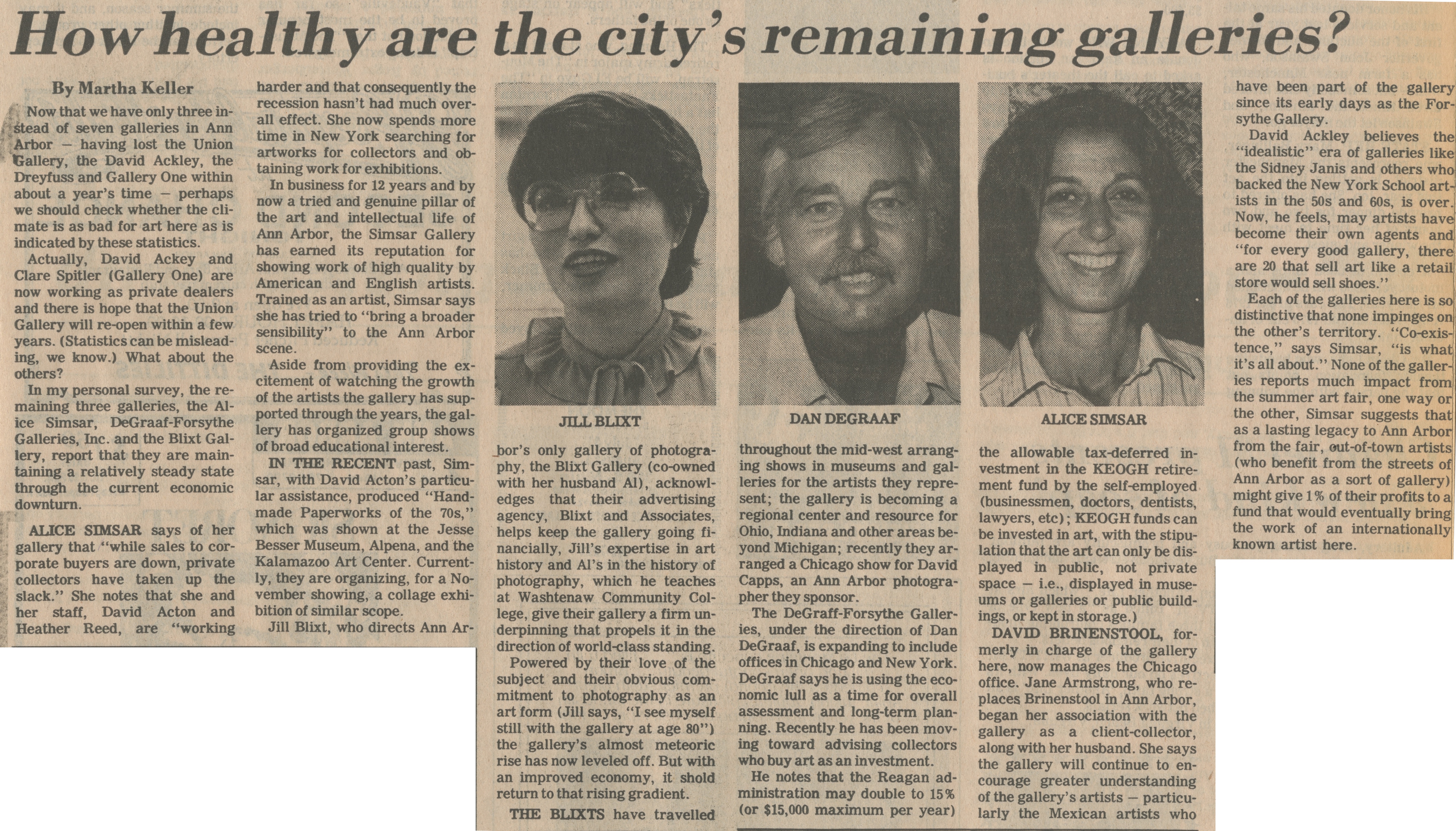How Healthy Are The City's Remaining Galleries?

How healthy are the city’s remaining galleries?
By Martha Keller
Now that we have only three instead of seven galleries in Ann Arbor -- having lost the Union Gallery, the David Ackley, the Dreyfuss and Gallery One within about a year’s time -- perhaps we should check whether the climate is as bad for art here as is indicated by these statistics.
Actually, David Ackey and Clare Spitler (Gallery One) are now working as private dealers and there is hope that the Union Gallery will re-open within a few years. (Statistics can be misleading, we know.) What about the others?
In my personal survey, the remaining three galleries, the Alice Simsar, DeGraaf-Forsythe Galleries, Inc. and the Blixt Gallery, report that they are maintaining a relatively steady state through the current economic downturn.
ALICE SIMSAR says of her gallery that “while sales to corporate buyers are down, private collectors have taken up the slack.” She notes that she and her staff, David Acton and Heather Reed, are “working harder and that consequently the recession hasn’t had much overall effect. She now spends more time in New York searching for artworks for collectors and obtaining work for exhibitions.
In business for 12 years and by now a tried and genuine pillar of the art and intellectual life of Ann Arbor, the Simsar Gallery has earned its reputation for showing work of high quality by American and English artists. Trained as an artist, Simsar says she has tried to “bring a broader sensibility” to the Ann Arbor scene.
Aside from providing the excitement of watching the growth of the artists the gallery has supported through the years, the gallery has organized group shows of broad educational interest.
IN THE RECENT past, Simsar, with David Acton’s particular assistance, produced “Handmade Paperworks of the 70s,” which was shown at the Jesse Besser Museum, Alpena, and the Kalamazoo Art Center. Currently, they are organizing, for a November showing, a collage exhibition of similar scope.
Jill Blixt, who directs Ann Arbor’s only gallery of photography, the Blixt Gallery (co-owned with her husband Al), acknowledges that their advertising agency, Blixt and Associates, helps keep the gallery going financially, Jill’s expertise in art history and Al’s in the history of photography, which he teaches at Washtenaw Community College, give their gallery a firm underpinning that propels it in the direction of world-class standing.
Powered by their love of the subject and their obvious commitment to photography as an art form (Jill says, “I see myself still with the gallery at age 80”) the gallery’s almost meteoric rise has now leveled off. But with an improved economy, it should return to that rising gradient.
THE BLIXTS have travelled throughout the mid-west arranging shows in museums and galleries for the artists they represent; the gallery is becoming a regional center and resource for Ohio, Indiana and other areas beyond Michigan; recently they arranged a Chicago show for David Capps, an Ann Arbor photographer they sponsor.
The DeGraff-Forsythe Galleries, under the direction of Dan DeGraaf, is expanding to include offices in Chicago and New York. DeGraaf says he is using the economic lull as a time for overall assessment and long-term planning. Recently he has been moving toward advising collectors who buy art as an investment.
He notes that the Reagan administration may double to 15% (or $15,000 maximum per year) the allowable tax-deferred investment in the KEOGH retirement fund by the self-employed (businessmen, doctors, dentists, lawyers, etc); KEOGH funds can be invested in art, with the stipulation that the art can only be displayed in public, not private space -- i.e., displayed in museums or galleries or public buildings, or kept in storage.)
DAVID BRINENSTOOL, formerly in charge of the gallery here, now manages the Chicago office. Jane Armstrong, who replaces Brinenstool in Ann Arbor, began her association with the gallery as a client-collector, along with her husband. She says the gallery will continue to encourage greater understanding of the gallery’s artists — particularly the Mexican artists who have been part of the gallery since its early days as the Forsythe Gallery.
David Ackley believes the “idealistic” era of galleries like the Sidney Janis and others who backed the New York School artists in the 50s and 60s, is over. Now, he feels, may artists have become their own agents and “for every good gallery, there are 20 that sell art like a retail store would sell shoes.”
Each of the galleries here is so distinctive that none impinges on the other’s territory. “Co-existence,” says Simsar, “is what it’s all about.” None of the galleries reports much impact from the summer art fair, one way or the other, Simsar suggests that as a lasting legacy to Ann Arbor from the fair, out-of-town artists (who benefit from the streets of Ann Arbor as a sort of gallery) might give 1 % of their profits to a fund that would eventually bring the work of an internationally known artist here.
JILL BLIXT
DAN DEGRAAF
ALICE SIMSAR
Article
Subjects
Martha Keller
Washtenaw Community College - Faculty & Staff
Union Gallery
Nickels Arcade
Gallery One
Dreyfuss Gallery
DeGraaf-Forsythe Gallery
David Ackley Gallery
Blixt Gallery
Blixt and Associates
Art Galleries
Alice Simsar Gallery
Has Photo
Old News
Ann Arbor News
Daniel L. DeGraaf
Jill Blixt
Jane Armstrong
Heather Reed
David Capps
David Brinenstool
David Alexander Blixt
David Acton
David Ackley
Clare Spitler
Alice Simsar